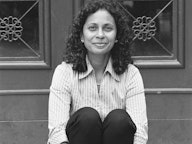
Sally Sarratt and Maria Swearingen
Washington, District of Columbia, USA
Being Fully Known and Seen for Who You Are
— Sally —
My two years in New York was a transformational time. It was the first place that I could imagine the possibility of being a person of faith and a person who loved someone of the same gender. It was the first place I had seen it, the first place I had seen queer people in church, period. And a church that said, “This is good. You are wonderful. You’re the beloved of God.” And that was back in I996, so it’s been a while ago now, too.
I say that one of the reasons my own vocational journey has made such a very big circuitous route is that I needed to have time to make room for myself. To describe faith, or my experience of God—it has just kept expanding. And in that expansion, I find room for myself, too.
It was really and truly the encounter with Maria that made it very clear to me that, yes, this is love like I’ve never experienced before. This whole circuitous journey came together at once. In that, I knew love, and I had a far more profound sense of my own calling.
That longing, that vocation, that calling towards people, towards questions of faith, accessing wisdom, all the different words for it; I think those things were happening at the same time and then it just all just started to come together. And these things don’t make sense, they don’t fit together. I don’t know how to live into all of it, to the fullness of myself, and yet….
You know you get pricked alive by love too, right? Pricked open. Yeah. One of the very first things that Maria ever declared to me was, “You have a pastor’s heart.” So, it was this being seen and known in the fullness of self, which I think is part of what the whole point of faith and religious experience is—to be fully human and to encounter others as fully human.
— Maria —
Probably the most significant time I relied upon faith was in the process of coming out to family, coming out to myself, making sense of how that shaped identity, and future, and vocation, and calling. I was in seminary at the time. I was both relying on a God that I hoped would be up for it and also sort of relying on a God I hadn’t met before. Like there was a new and brewing conception of God being formed while I was also relying on that God. So, it was a strange and wondrous time.
Sometimes I joke that everyone should have to come out of something just to see what happens to the soul. Just to kind of jiggle things up. It was a deeply spiritual process to face myself; to face that wall of uncertainty of others. Like, where will this go? Where will this not go? What will be lost? In there, I have deep and profound experiences of all of it: of great loss, of great gain, of great joy, of great heartache, and I think all of that in its own way is fortifying for the soul.
A friend and colleague taught us a helpful re-frame for coming out. It is to imagine it as ‘inviting in’ instead of ‘coming out’ because it changes the locus of gravity and power. When you’re coming out, it’s just this never-ending revolving door of anxiety: “And I’m gonna come out now…. And I’m gonna come out now.... And I hope it goes well.... And I don’t know if it will….” This is versus inviting in, saying, “This is my life, and this is the force field of my life. And I'm telling you that I trust you enough to welcome you into it.”
And that was a pretty cataclysmic moment for me—that shift of language—to understand it. It still is coming out. There’s still vulnerability and anxiety, but like shifting it to re-centering myself as sort of the locus. And saying, “Actually, I’m inviting you in. And you may accept or reject that invitation. Please keep me posted. RSVP. But this is your invitation into my life.”
The capacity to love is just the most bizarre and wondrous mystery. It can be wrenching, but wow, is it incredible when we find that centered place that we can love from and be loved by. I have the capacity to be a participant in giving life to people. It’s pretty mind-boggling when we take long enough to reflect on it. I see that expressed in life and marriage with Sally, in deep and abiding and consistent and unexpected ways over and over again. When I’m counseling a couple who are thinking about marriage, or are going to be married, I talk about what it means to try to choose or build a life with someone who helps you fall in love with the world.
Daniel’s Reflection
Sally Sarratt and Maria Swearingen are co-senior pastors of Calvary Baptist Church in Washington, D.C., and they are a gay married couple. I’ve known Sally since she was a brand manager at Procter & Gamble, before her journey took her to divinity school. What I loved so much about my interview with Sally and Maria was that their journeys of “coming out” as gay, their journeys of falling in love, and their journeys to ministry were all beautifully and necessarily intertwined. And when I step back and reflect on these three things, they are all about being seen and known for who we really are in the world and seeing and knowing others for who they truly are in the world. I loved that one of the first things that Maria said to Sally was “You have a pastor’s heart.” That level of being seen and known is life changing.
I remember the first time I felt seen and known. It was from my then girlfriend, Anne Harbison, whom I dated for five years while we were both at Procter & Gamble and then when she went on to diversity consulting and Harvard Divinity School. She saw in me and reflected back to me a spirituality I had not known but had deeply felt. She awakened in me a curiosity about faith and the spiritual journey. When we met, she was taking part in a spiritual autobiography course at a local church that bears so much resemblance to the Portraits in Faith journey I’ve been traveling.
The first time I felt unconditional love was from my dear friend, David Charpentier, who I met in 1999 in a men’s group. He reflected back to me what he saw about myself, yet I could not see. He’d seen that I was a loving and lovable member of the human race. He and his wife gave me two godchildren, and one of them is even named for me (my Goddaughter’s middle name is Danielle). With no strings attached, I felt the love of a friend who saw me, flaws and all, to be fully and magnificently human…and invited me to be part of their family.
Three years ago, I met the love of my life, Gina Mellinger Alicea, on spiritualsingles.com. Gina was drawn in by my commitment to a spiritual life and to being a loving, respectful, and honest partner. And I did and do feel seen for all of who I am with Gina, and I honor all of who she is. I have learned so much from her Mennonite upbringing and her current ministry in the world of Centers for Spiritual Living. Gina turned Portraits in Faith into a museum exhibition and so now we share in that expression of art and spirituality. For me, the ‘tip of the spear’ of my life and the best version of me is the guy working on this Portraits in Faith project—and I feel Gina’s love and support so I can be that person.
Maria said that instead of calling it “coming out” when someone shares they are gay with family and friends, it should be called “inviting in.” Now that I have had these pivotal experiences of being seen and known, I feel more confident in “inviting in” people into my life, and I am unphased when someone is not interested. Knowing who I am and what matters has been the most clarifying lesson. And I am so grateful to the three people who helped me see myself clearly.
Thank you to Rev. Sally Sarratt and Rev. Maria Swearingen for sharing with me the story of their love, the story of their “inviting in,” and the story of their call to ministry and all that this provoked in me. To be seen and to be known for all of who we are is a gift.
Explore the portraits by theme
- happiness
- grief
- addiction
- sexuality
- sobriety
- transgender
- alcoholism
- suicide
- homelessness
- death
- aggression
- cancer
- health
- discipline
- abortion
- homosexuality
- recovery
- connection
- enlightenment
- indigenous
- depression
- meditation
- therapy
- anger
- forgiveness
- Doubt
- interfaith
- worship
- salvation
- healing
- luminaries

